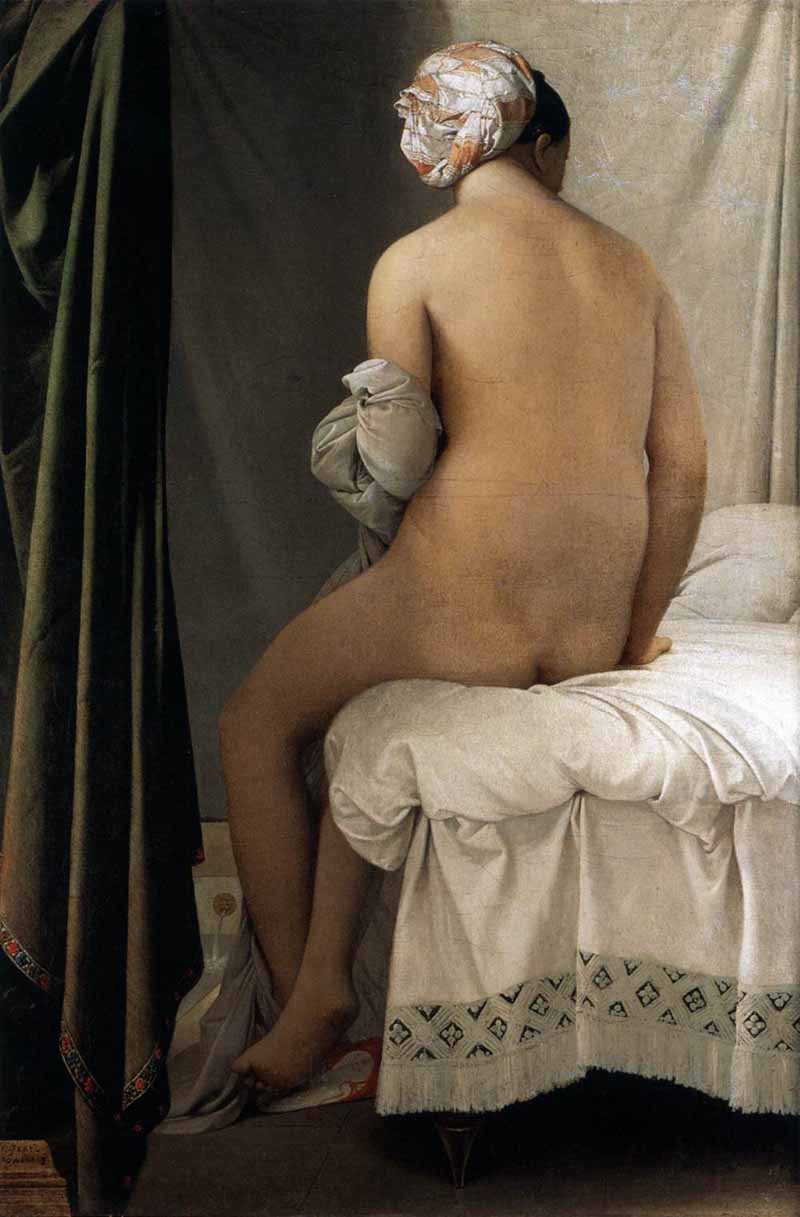
The Valpinçon Bather. Jean-Auguste-Dominique Ingres
1808
Oil on canvas, 146 x 97 cm
Musée du Louvre, Paris
---
----
----
The Valpinçon Bather (Fr: La Grande Baigneuse) is an 1808 painting by the French Neoclassical artist Jean Auguste Dominique Ingres (1780-1867), held in the Louvre since 1879. Painted while the artist was studying at the French Academy in Rome, it was originally titled Seated Woman but later became known after one of its nineteenth-century owners.
Although the painting was not met with favour by critics when first exhibited, almost fifty years later, when the artist's reputation was well established, the Goncourt brothers wrote that "Rembrandt himself would have envied the amber color of this pale torso", while the Louvre described it as "a masterpiece of harmonious lines and delicate light".[1]
Ingres had earlier painted female nudes, such as his Bathing Woman of 1807, yet this work is widely regarded as his first great treatment of the subject. As with the previous smaller work, the model is shown from behind, however The Valpinçon Bather lacks the earlier painting's overt sexuality, instead depicting a calm and measured sensuality.[2]
Venus Italica (1812) by Antonio Canova. Ingres's painting may be influenced by it and, directly or indirectly, its predecessor, the "Medici Venus."
Charles Baudelaire (1821-1867) described the model as having a "deep voluptuousness", yet in many ways she is presented as essentially chaste.[1] This contradiction is apparent in many elements of the painting. The turn of her neck and the curves of her back and legs are accentuated by the fall of the metallic green draperies, the swell of the white curtain in front of her and the folds of the bed sheets and linen. However, these elements are countered by the cool tone in which her flesh is rendered as well as by elements such as the elegant black-veined marble to the left of her.[2]
Remarking on Ingres ability to paint the human body in a unique manner, the art critic Robert Rosenblum wrote that "the ultimate effect of the [The Valpinçon Bather] is of a magical suspension of time and movement-even of the laws of gravity...the figure seems to float weightlessy upon the enamel smoothness of the surface, exerting only the most delicate pressure, and the gravitational expectations of the heaviest earthbound forms are surprisingly controverted."[2]
Ingres' The Turkish Bath (1862)
Ingres returned to the form of this figure a number of times in his life; culminating in his The Turkish Bath of 1863, where the central figure in the foreground playing a mandolin, echoes in rhythm and tone the model of the Valpinçon bather.[3][4]
Notes
"The Bather, known as the Valpinçon Bather". Louvre. Retrieved on May 08, 2009.
Rosenblum, 66
Rosenblum, 128
Mirzoeff, Nicholas. "Bodyscape". Routledge, 1995. 116. ISBN 0-415-09801-7
Sources
Rosenblum, Robert. Ingres. London: Harry N. Abrams, 1990. ISBN 0-300-08653-9
Siegfried, Susan & Rifkin, Adrian. Fingering Ingres. Wiley-Blackwell, 2001. ISBN 0-631-22526-9
Retrieved from "http://en.wikipedia.org/"
All text is available under the terms of the GNU Free Documentation License


